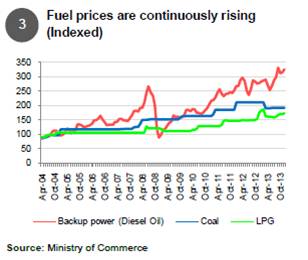Geothermal Energy and its Potential in India
We all know about solar, wind, Hydropower but there are a host of other renewable technologies that have not been tapped to their fullest potential in our country. Geothermal Energy is generated due to the natural decay of radioactive elements inside the earth. A temperature gradient is thus formed which results in energy release. Hot bath systems are not uncommon and have been prevalent since ancient times but such geothermal energy sources can be put to many other uses.
There is always some emissions associated with geothermal energy but they are low when compared to fossil fuels and it is thus a better option for a country looking to cut down its total emissions. It is not intermittent and is independent of weather fluctuations or seasonal availability.
As per the Geothermal: International Market Overview Report of the Geothermal Energy Association, “As of May 2012, approximately 11,224 MW of installed geothermal power capacity was online globally.”1
Deep wells can be drilled into underground reservoirs to tap steam and very hot water that in turn drives turbines for electricity generation. Four types of power plants are in use at present:
Flashed steam plant
The extremely hot water from drill holes is released and generates the turbine. Steam is condensed and returned to the reservoir again.
Dry steam plant
Used for geysers. Steam from the reservoir is used to rotate the turbine, after sending the steam through a rock-catcher. The rock-catcher protects the turbine from rocks.
Binary power plant
The hot water is passed through a heat exchanger and the heat is transferred to a secondary liquid, namely isobutene, iso-pentane or ammonia–water mixture. The secondary liquid turns into vapour and is used to rotate turbines. The binary system is useful in cases where the heat generated from a geothermal reserve is of lower grade and cannot be used directly.

Hybrid power plant
It is a combination of flash and binary systems and is used for plants where the geothermal reserves produce both steam and water.
Enhanced geothermal system
It refers to the act of artificially creating hydrothermal resources (underground steam and hot water) that can be used to generate electricity in naturally dry geological formations.
Uses of Geothermal Energy-
- For Electricity Generation:
Electricity generation does not rely unlike solar and wind on intermittent sources of energy so capacity is high even though efficiency is low.
- Heating:
Low-temperature geothermal resources can be used for heating, for maintaining temperatures in greenhouses, fisheries, for mineral recovery, and industrial heating.
- Drying applications such as in paper and pulp industry, drying timber or any application where heat is required
- Melting of snow and ice on roads and pavements
- Sterilization
According to some ambitious estimates, India has 10,600 MW of potential in the geothermal provinces. Whatever be the potential, it has not been exploited till now.
The thermal springs of India have been classified as follows:
| Himalayan Province | Areas of Faulted blocks – Aravalli belt, Naga-Lushi, West coast regions and Son-Narmada lineament. | Andaman and Nicobar |
| Deep sedimentary basin of Tertiary age such as Cambay basin in Gujarat | Radioactive Province – Surajkund, Hazaribagh, Jharkhand. | Cratonic province – Peninsular India |
Table Source: GSI
Unlike traditional power plants that run on fuel, geothermal power plants use a renewable resource that needn’t be imported. However, the initial costs will be on the higher side because of exploration costs and the possibility of only one in many explorations resulting in a sustainable and useful reservoir.
Reference and further reading-
Basics of geothermal energy and its uses




Plz suggest geothermal for home project in Punjab.
Hi, I am not aware of Geo-thermal based domestic technology. However, will love to hear on it.
USE OF HEAT PUMPS F USE OF HEAT PUMPS FOR SPACE HEATING DUTING WINTER AND FOR ROOM COOLING IN SUMMER IN PUNJAB